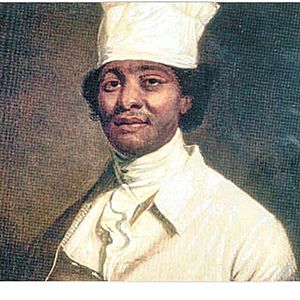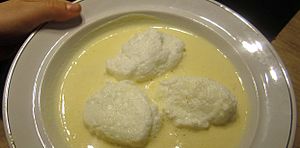James Hemings facts for kids
Quick facts for kids
James Hemings
|
|
|---|---|

Painting by Rembrandt Peale
|
|
| Born | 1765 |
| Died | 1801 (aged 35–36) |
| Nationality | American |
| Occupation | Chef de cuisine, cook |
| Parent(s) | Betty Hemings John Wayles |
| Relatives | Hemings family |
James Hemings (1765–1801) was an important African American chef. He was the first American to train as a chef in France. James was born in Virginia in 1765. When he was 8 years old, he was enslaved by Thomas Jefferson.
James was the older brother of Sally Hemings. He was also a half-sibling of Jefferson's wife, Martha Jefferson. They shared the same father, John Wayles. As a young man, James was chosen by Jefferson to go with him to Paris. Jefferson was going to be a diplomat in France. In Paris, James learned to be a French chef. He also took lessons to learn the French language.
James returned to the United States with Jefferson. He likely wanted to be near his large Hemings family at Monticello. Jefferson continued to pay James wages as his chef. James worked for Jefferson in Philadelphia. He talked with Jefferson about his freedom. James became free in 1796. This happened after he trained his brother Peter for three years to take his place as chef. James Hemings died at age 36.
Contents
Biography of James Hemings
Early Life and Family History
James Hemings was born into slavery. His mother was Betty Hemings. She was the daughter of an enslaved African mother and an English sea captain. James was the second of six children Betty had with John Wayles. Wayles was Betty's enslaver. After Wayles died in 1773, Betty and her ten children became enslaved by Martha Jefferson. Martha was Wayles's daughter and was married to Thomas Jefferson.
In 1784, Thomas Jefferson took James Hemings to Paris. James was 19 years old at the time. Jefferson wanted James to be trained as a chef. While they were in France, Jefferson paid James a wage of four dollars each month. For the first three years, James studied cooking. He learned from pastry chefs and other cooking experts. He even learned from a prince's chef. James also paid for a French tutor to learn the language.
He became the head chef, or chef de cuisine, in Jefferson's kitchen in Paris. He cooked amazing meals for important European guests. These guests included aristocrats, writers, and scientists.
Culinary Career and Achievements
While in France, James Hemings learned to make a French dish of pasta and cheese. He called this dish "macaroni pie." This dish later became what we know today as macaroni and cheese. James is thought to be one of the first American chefs to make this French dish in America. However, people often wrongly give credit to Thomas Jefferson's cousin, Mary Randolph. She included a similar recipe in her famous cookbook, The Virginia House-Wife.
Another dish James brought to American cooking is called Snow Eggs. This is a French dessert made of meringue and custard.
While in Paris, Jefferson worried that James might learn he could be free. France had ended slavery in 1789. James and his future mother, Sally Hemings, thought about staying in France to be free. Sally Hemings had also traveled to France with one of Jefferson's daughters. Jefferson was worried about losing James. He had paid a lot for James's cooking training.
Journey to Freedom
In 1789, James Hemings returned to America with Jefferson. Jefferson continued to pay James wages to work as his chef. They first went back to Monticello. Then they lived for a short time in New York City. James Hemings managed the kitchen there. In 1791, James Hemings and Jefferson were living in Philadelphia. James went with Jefferson and James Madison on a month-long trip. They traveled through New York and Vermont. James often traveled ahead to arrange places for them to stay.
Pennsylvania did not allow slavery. So, Jefferson paid James a wage while he worked there. After two years in Philadelphia, Jefferson planned to return to Virginia. James did not want to go back to a slave state. He made a deal with Jefferson. He would become free after he trained a new chef at Monticello to take his place.
In 1793, Jefferson wrote an agreement. It said that James would be free after he trained someone else. James had served Jefferson well for many years. Some historians say this was a difficult way for him to gain freedom.
For two years, James trained his younger brother Peter. Peter was also enslaved from birth. James finally gained his freedom in 1796. He could speak French and English. He could also read and write. His handwritten list of kitchen supplies is kept at the Library of Congress. He also left behind recipes and other writings.
After traveling in Europe, James returned to the United States. He found work as a cook in Philadelphia. Not much is known about James Hemings's personal life. He never married or had children. Most of what we know about him comes from records related to Thomas Jefferson.
In 1801, Jefferson offered James a job at the White House. James turned it down. He felt he could not leave his job in Baltimore right away. Jefferson asked a second time. James replied through a friend, Francis Sayes. James said he would work for Jefferson before anyone else. But he wanted to know the conditions and wages in writing. Jefferson did not write to James. He said he did not want to "urge him against inclination."
James later returned to Monticello for a short time. He worked in the kitchen for a month and a half. He earned thirty dollars before leaving again. He then worked as a cook in a tavern in Baltimore. He died there at age 36.
On November 9, 1801, Jefferson wrote about James's death. He sent a letter to James Dinsmore, who worked at Monticello. Jefferson likely wanted James's mother Betty and brother John Hemings to know. On December 4, 1801, Jefferson wrote to his son-in-law. He called James's death a "tragical end."


